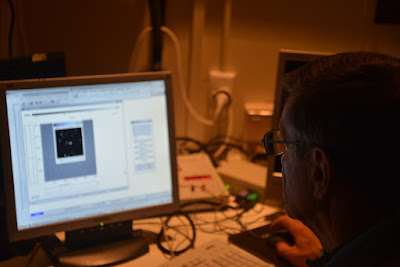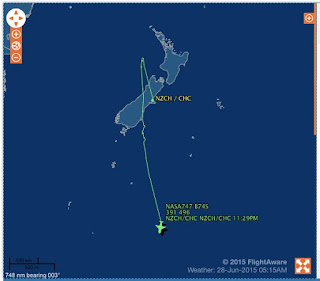The data resolution has been intentionally reduced because, well, we're still working on the analysis.
Data from HIPO (red) aboard SOFIA
Program PI: Dr. Michael Person (MIT)
HIPO PI: Dr. Ted Dunham (Lowell)
Video by: Luke Weisenbach (MIT)
On UT 29 June 2015, Pluto occulted a star (m=11.9) in Sagittarius. A group of astronomers and students of astronomy from MIT, Lowell Observatory, and Williams College traveled to New Zealand and Australia to observe this occultation, with the goal of studying Pluto's atmosphere. Follow the adventures!
 |
An early glimpse of the telescope domes
on Mt. John. This is the view
from part way up the access road
looking to the south.
|
 |
From the summit of Mt. John, looking down to
the south at the 1-meter Mc.Lellan
telescope and support building.
|
 |
The Astro Cafe up on the summit of
Mt. John serves up thematically
appropriate drinks, which we sampled
on the afternoon before the occultation.
|
 |
Looking down from Mt John to the town
of Tekapo, which is on the south end of Lake Tekapo.
|
 |
| The Optical Craftsmen telescope dome. |
 |
Me, standing with the
Optical Craftsmen
telescope and the near IR camera
(blue box on the end of the
telescope).
|
 |
Jupiter and Venus are
visible over the MOA
telescope dome at sunset on
the night of the occultation.
|
 |
| Visiting SOFIA after the event. (L-R): Jay Pasachoff, Naomi Pasachoff, Tina Seeger, Becky Durst, Bryce Babcock, Rob Lucas [all from Williams College], and Stephen Levine [Lowell Obs.] |
 |
| In the control room at the 1-m at Mt. John: Bryce Babcock |
 |
| In the control room at the 1-m at Mt. John: Tina Seeger and Rebecca Durst monitor the data. |
 |
| Images from SOFIA's Facebook page. [The flight plan (bottom) has a glitch, the sharp spike to the left isn't real.] |
 |
| At UT17:55, SOFIA has turned and is heading back to Christchurch for landing. |
 |
|
 |
|
Photo credit:Maryrose Fowlie, Mt. John University Observatory
 |
While walking along the south shore of Lake
Tekapo, I saw this group of gulls sitting on a rock in Lake Tekapo.
Mt John is behind them, and the observatory buildings are visible on
the ridge line.
|
 |
Looking west from the OC61 dome a bit
after sunset. This was one of the few pictures not blurred out. To
get this, I was facing into the wind, which was about 60 to 70 kph.
|
 |
Readout from the Mt. John weather station. For
much of the late afternoon and evening,
the wind was variable out of
the west, between about 60 and 80 kph,
and peaking over 100 kph.
|
 |
An enticing sign at the start of the trail
from Lake Tekapo to the summit of Mt. John.
|
 |
The 61cm Optical Craftsman telescope. The near IR
camera that Henry Roe lent us is the blue box mounted at the back end
of the telescope.
|
 |
| The stars of Sagittarius (center) and Capricorn (upper left) peek through clouds in Flagstaff. |
 |
| See SOFIA's flight path on FlightAware |
 |
| (L-R): Jay Pasachoff, Becky Durst, Tina Seeger, and Bryce Babcock |
 |
| (L-R): Jay Pasachoff, Bryce Babcock, Tina Seeger, and Becky Durst |
 |
| (L-R): Tina Seeger, Rob Lucas, Bryce Babcock, and Becky Durst |
 |
Venus and Jupiter visible above Mt John. The
light on the mountain is coming from
some building on Mt John at about
the location of the observatory. (2015 June 26)
|
 |
Early evening after sunset in Lake
Tekapo. This view is looking northish
over the lake from the front of
the motel where I am staying. (2015 June 26)
|
 |
The east slope of Mt John illuminated by
the rising sun. (2015 June 27)
|
 |
Looking across Lake Tekapo; clouds above
some of the peaks to the north
are illuminated. (2015 June 27)
|
 |
SOFIA at the Christchurch airport on the
evening of 2015 June 26. Venus
and Jupiter are above the tail.
|
 |
The front of SOFIA with Venus and Jupiter
above. (2015 June 26)
|
 |
The flying hippo on the HIPO control computer.
Note the SOFIA pin. (2015 June 26)
|
 |
HIPO + FLITECAM installed on SOFIA. FLITECAM is
the large blue cylinder sticking out
horizontally from the center, and
HIPO is the large black box beneath it. (2015 June 26)
|
 |
| Luke Weisenbach checks out Hilmar Batza’s Meade 10-inch LX200 telescope, while Hil glances over the top. |
 |
| Steph Sallum adjusts the occultation camera on the telescope. Peter Nelson is just to the left of the telescope, and Hil is to the left of Peter. |

